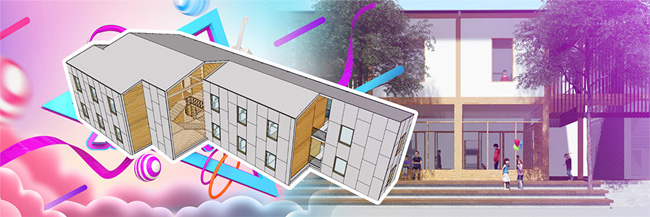Where you can study design and art in Korea, China, Taiwan and Mexico

 Tsinghua University was established in 1911, originally under the name “Tsinghua Xuetang”. The school was renamed "Tsinghua School" in 1912. The university section was founded in 1925. The name “National Tsinghua University” was adopted in 1928.
Tsinghua University was established in 1911, originally under the name “Tsinghua Xuetang”. The school was renamed "Tsinghua School" in 1912. The university section was founded in 1925. The name “National Tsinghua University” was adopted in 1928.
The faculty greatly valued the interaction between Chinese and Western cultures, the sciences and humanities, the ancient and modern. Tsinghua scholars Wang Guowei, Liang Qichao, Chen Yinque and Zhao Yuanren, renowned as the "Four Tutors" in the Institute of Chinese Classics, advocated this belief and had a profound impact on Tsinghua's later development.
Tsinghua University was forced to move to Kunming and join with Peking University and Nankai University to form the Southwest Associated University due to the Resistance War against the Japanese Invasion in 1937. In 1946 The University was moved back to its original location in Beijing after the war.
After the founding of the People's Republic of China, the University was molded into a polytechnic institute focusing on engineering in the nationwide restructuring of universities and colleges undertaken in 1952. In November 1952, Mr. Jiang Nanxiang became the President of the University. He made significant contributions in leading Tsinghua to become the national center for training engineers and scientists with both professional proficiency and personal integrity.
Since China opened up to the world in 1978, Tsinghua University has developed at a breathtaking pace into a comprehensive research university. At present, the university has 14 schools and 56 departments with faculties in science, engineering, humanities, law, medicine, history, philosophy, economics, management, education and art. The University has now over 25,900 students, including 13,100 undergraduates and 12,800 graduate students. As one of China’s most renowned universities, Tsinghua has become an important institution for fostering talent and scientific research.
The educational philosophy of Tsinghua is to "train students with integrity." Among over 120,000 students who have graduated from Tsinghua since its founding are many outstanding scholars, eminent entrepreneurs and great statesmen remembered and respected by their fellow Chinese citizens.
With the motto of “Self-Discipline and Social Commitment” and the spirit of “Actions Speak Louder than Words”, Tsinghua University is dedicated to the well-being of Chinese society and to world development.
 The Hong Kong Polytechnic University:
The Hong Kong Polytechnic University:
The goal for the department is to become a world class academic department in fashion and, textile education, research and knowledge transfer with the following taken as the key objectives for ITC from 2009/10 and onwards:
to provide professional education covering the whole spectrum of activities in fashion and textiles, and develop “all-round” graduates with vision and a global outlook, a sense of social responsibility, critical and creative thinking ability
to conduct research to create and disseminate knowledge to the academic community, commerce, industry, society and the world at large
to continue the review of academic programmes in fashion and textiles
to further enhance learning and teaching in both teaching methodology and practice, the implementation of outcome-based learning, maintain and upgrade an environment that facilitates learning, with an aim to stimulate students’ interest in learning
to collaborate with partners on the development of preferred continuing education in fashion and textiles
to become an area of excellence in fashion and textile education and research, regionally and internationally
to lead and enhance the development of the fashion and textile industry
 National University of Singapore:
National University of Singapore:
A leading global university centred in Asia, influencing the future;
"Our focus will centre on nurturing future-ready graduates, enhancing our research's translational impact and making NUS Asia's most vibrant university enterprise ecosystem. Our goal? More distinctive, high-impact value for Singapore and the world."
Tan Chorh Chuan
NUS Presiden
 Seoul National University:
Seoul National University:
A Tradition of Excellence Honoring Public Service Pioneering Knowledge Seoul National University honors the ideals of liberal education and aims to teach students a lifelong love of learning that will form the basis for continuous personal growth.
At the same time it is committed to preparing students to work and live in an increasingly competitive global environment. As South Korea's first national university, Seoul National University has a tradition of standing up for democracy and peace on the Korean peninsula.
Graduates have long served as public servants in key positions of the Korean government. In teaching, research, and public service, Seoul National University continues to set the standard of excellence.
The mission of Seoul National University in the twenty-first century is to create a vibrant intellectual community where students and scholars join together in building the future. As Korea's leading research university, Seoul National University is committed to diversifying its student body and faculty, fostering global exchange, and promoting path-breaking research in all fields of knowledge.
 The National Autonomous University of Mexico:
The National Autonomous University of Mexico:
as a mission to teach higher education courses to educate professionals, researchers, university professors, and technicians who will provide a useful service to society; to organize and to carry out research, primarily on the national conditions and problems, and to extend with generosity the benefits of culture to all sectors of the population.
Its substantive functions are teaching, research, and dissemination of culture. Its organizational structure is divided into three sub-systems to achieve its task. These are: on the one hand, education, which includes undergraduate, master and doctoral programs; research, which is done in its schools, and in its institutes and centers of natural and exact sciences, and on the other hand, humanities and social sciences as well as cultural dissemination.
The National Autonomous University of Mexico has two high schools: The National Preparatory School with nine facilities, and the Sciences and Humanities School with five facilities. High school in Mexico corresponds to prep school, and it is studied in three years after middle school and before the undergraduate degree.
Undergraduate programs are taught in 22 schools and national schools located in Mexico City and its Metropolitan Area, and in some institutes, centers and units located in different states of Mexico. This infrastructure enables UNAM to offer 117 programs in all disciplines of human knowledge.
UNAM has five Higher Education Schools, four in the State of Mexico and one in Mexico City, which were established in the seventies within the framework of an education decentralization project in order to benefit a larger number of students, introduce educational innovations, to impel inter-discipline and multi-discipline, to link research and teaching, to integrate theory and practice and to relate to its environment.
Through the Open University and the Distance Education System, UNAM offers twenty-two undergraduate programs, one technical program, one distance high school, four doctoral and fourteen master programs, in twelve schools, two national schools, and one extension center in the University itself, as well as in the states of: Chiapas, Mexico, Guerrero, Oaxaca, Tabasco, and Tlaxcala.
UNAM offers 41 postgraduate programs with 83 curricula for master and doctoral programs, with the advantage that these are jointly taught by diverse academic entities of the National University schools, institutes, and centers offering the students a major variety of expert tutors in different branches of the discipline of their choice. It also offers 30 programs in 167 specializations.
The Coordination of Humanities encourages the development of humanistic disciplines and of social sciences disseminating the knowledge generated by the researchers of ten institutes. seven centers. three programs, and an academic unit outside Mexico City which constitute UNAM Subsystem of Humanities.
Research in scientific areas is done in nineteen institutes; ten centers, and five programs gathered in the Coordination of the Scientific Research.
The Coordination of Culture Dissemination is the area of UNAM in charge of fostering and disseminating culture and of managing the university extension activities. To achieve this, UNAM counts with the Cultural University Center, in University City, the Tlatelolco Cultural University Center, Radio UNAM, as well as with thirteen museums inside and outside of University City.
 National Taiwan University:
National Taiwan University:
NTU's institutional predecessor was Taihoku Imperial University, founded in 1928 by the Japanese colonial administration. The first president was Shidehara Tan Tairaka Hiroshi. In 1945, the Republic of China won the war of resistance against Japan, and Taiwan was handed over to the Nationalist government of China. On November 15 of that year, Taihoku Imperial University was formally transferred to Chinese administration and renamed as National Taiwan University, with Dr. Tsung-lo Lo appointed as the first President.
During the Japanese occupation, the University consisted of two academic divisions: the Literature and Politics division and the Science and Agriculture division, with about 60 students enrolled each semester. The Medical division was added in 1936, followed by the Engineering division in 1943. Additionally, the University included the affiliated Agriculture and Forestry division, the affiliated Medical special division, a Tropical Medicine research institute and a preparatory school. Also, in 1943 the Southern Humanities research institute and the Southern Resource research institute were added. At that time, each division operated according to the lecture system, with a full-time Professor in charge of a faculty of associate professors, lecturers, teaching assistants and staff. These divisions and institutes were financially independent and had their own libraries. By 1945, the university expanded to five divisions, including Literature and Politics, Science, Agriculture, Medicine and Engineering, with a total enrollment of 382 students.
After restructuring in accordance with the ROC academic system in 1945, academic departments were established and the former divisions were renamed Colleges. The Literature and Politics division was divided into the College of Liberal Arts and the College of Law. Additionally, colleges of Science, Medicine, Engineering and Agriculture were established. Initially, there were six colleges with 22 departments. In 1945, student enrollment was 585. In the following years, the departments and colleges expanded in faculty and hardware in step with growing budgets and rising social expectations. In 1960, the night school was initiated on a trial basis, and in 1967 a new night school was established. In 1987, the College of Management was established, followed by the College of Public Health in 1993 and the College of Electrical Engineering in 1997. The College of Electrical Engineering was later rechristened the College of Computer Science and Electrical Engineering; in 1999, the College of Law was renamed the College of Social Sciences, and the Night Division and the Center for Continuing Education were combined to form the School for Professional and Continuing Studies. In 2002, the College of Agriculture was renamed the College of Bio-resources and Agriculture, and in 2002 a College of Life Sciences was added. Now, the university has 11 colleges, with 54 departments and 103 graduate institutes, plus four university-level research centers: Population and Gender Studies Center, Center for Condensed Matter Sciences, Center for Biotechnology, and Bio-diversity Research Center. The total number of students, including those enrolled at the School of Professional and Continuing Studies, has grown to over 33,000, including over 17,000 university students and 15,000 graduate students. Now, the number of graduate students at NTU almost equals the number of university students, which indicates that NTU has successfully been transformed into a research university.
Hits: 11722 | Leave a comment



















